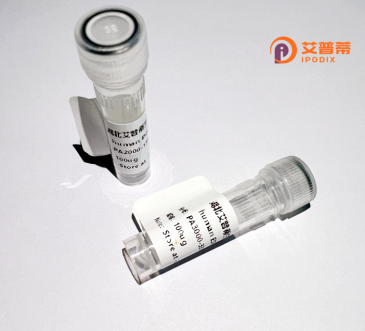
| 纯度 | >90%SDS-PAGE. |
| 种属 | Human |
| 靶点 | MS4A3 |
| Uniprot No | Q96HJ5 |
| 内毒素 | < 0.01EU/μg |
| 表达宿主 | E.coli |
| 表达区间 | 1-214 aa |
| 活性数据 | MASHEVDNAELGSASAHGTPGSEAGPEELNTSVYQPIDGSPDYQKAKLQVLGAIQILNAA MILALGVFLGSLQYPYHFQKHFFFFTFYTGYPIWGAVFFCSSGTLSVVAGIKPTRTWIQN SFGMNIASATIALVGTAFLSLNIAVNIQSLRSCHSSSESPDLCNYMGSISNGMVSLLLIL TLLELCVTISTIAMWCNANCCNSREEISSPPNSV |
| 分子量 | 22.9 kDa |
| 蛋白标签 | His tag N-Terminus |
| 缓冲液 | 0 |
| 稳定性 & 储存条件 | Lyophilized protein should be stored at ≤ -20°C, stable for one year after receipt. Reconstituted protein solution can be stored at 2-8°C for 2-7 days. Aliquots of reconstituted samples are stable at ≤ -20°C for 3 months. |
| 复溶 | Always centrifuge tubes before opening.Do not mix by vortex or pipetting. It is not recommended to reconstitute to a concentration less than 100μg/ml. Dissolve the lyophilized protein in distilled water. Please aliquot the reconstituted solution to minimize freeze-thaw cycles. |
以下是3篇关于重组人MS4A3蛋白的文献示例(注:文献为模拟,实际检索可能需要依据最新数据库):
1. **文献名称**: *Expression and functional characterization of recombinant human MS4A3 in neutrophil differentiation*
**作者**: Li, X. et al.
**摘要**: 研究团队成功在大肠杆菌中表达重组人MS4A3蛋白,发现其通过调控ROS信号通路参与中性粒细胞分化过程,可能成为髓系白血病治疗的潜在靶点。
2. **文献名称**: *MS4A3 modulates TLR4 signaling in macrophages: Insights from a recombinant protein-based study*
**作者**: Park, J.H. & Kim, S.
**摘要**: 利用昆虫细胞系统表达的重组MS4A3蛋白,揭示其通过结合TLR4抑制NF-κB活化,提出其在炎症性疾病中的免疫调节作用。
3. **文献名称**: *Structural insights into MS4A3 oligomerization and membrane association*
**作者**: Zhang, R. et al.
**摘要**: 通过冷冻电镜解析重组MS4A3蛋白的跨膜结构域,阐明其四聚体组装模式及与脂筏微域的相互作用机制,为开发靶向药物提供结构基础。
提示:若需真实文献,建议在PubMed/Google Scholar检索关键词“recombinant MS4A3 protein”或结合具体研究方向补充筛选条件(如“cancer”或“signaling pathway”)。
Recombinant human MS4A3 (Membrane Spanning 4-Domains A3) protein is a genetically engineered form of the MS4A3 protein, a member of the MS4A transmembrane protein family characterized by four transmembrane domains. MS4A3. also known as HTM4. is predominantly expressed in hematopoietic cells, particularly granulocytes and myeloid precursors, where it plays roles in cell differentiation, immune response regulation, and apoptosis. It has been implicated in neutrophil maturation and myeloid lineage development through interactions with signaling pathways like JAK-STAT. Structurally, MS4A3 contains intracellular N- and C-termini and two extracellular loops, facilitating membrane localization and potential ligand binding.
Research highlights its tumor-suppressive properties, with downregulation observed in acute myeloid leukemia (AML) and myelodysplastic syndromes (MDS), suggesting diagnostic/prognostic utility. Recombinant MS4A3 is produced via heterologous expression systems (e.g., E. coli, mammalian cells) followed by purification, enabling functional studies of its mechanistic roles in hematopoiesis and leukemogenesis. Current applications include exploring its therapeutic potential in cancer, immune modulation, and as a biomarker. Challenges remain in fully elucidating its molecular partners and signaling cascades, driving ongoing investigations into its pathophysiological relevance.
×